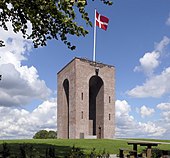geo.wikisort.org - Mountains
Ejer Bavnehøj (also spelled Ejer Baunehøj) is the third-highest natural point in Denmark (170.35 m).
| Ejer Bavnehøj | |
|---|---|
 Ejer Bavnehøj as seen from the north east, April 2021 | |
| Highest point | |
| Elevation | 170.35 m (558.9 ft) |
| Coordinates | 55°58′37″N 09°49′50″E |
| Geography | |
 Ejer Bavnehøj Location of the hill in Denmark | |
| Location | Skanderborg municipality, Denmark |
Geography
It lies in the southern part of Skanderborg municipality, between the villages of Riis and Ejer. At its summit is a 13 m tall tower, built in 1924, commemorating the reunion of the south of Jutland with the rest of Denmark after the First World War.
Close to Ejer Bavnehøj lies Yding Skovhøj, another high point, with a height of 172.66 m above sea level but this includes a human built Bronze Age burial mound. Without the Bronze Age mound Yding Skovhøj is a little lower than Denmark's highest non-man-made point, Møllehøj, which is 170.86 m high, 51 cm higher than Ejer Bavnehøj.
History

Historically Ejer Bavnehøj was mostly known as a site for a beacon where signal-fires were lit in order to warn the military and local population if the enemy were on the way.[1] The second part of the name, "Bavnehøj", can literally be translated into "Beacon Hill" (bavne meaning "beacon" and høj, from the Old Norse word haugr, meaning hill).
References
- Steltzner, Knud. "Ejer Bavnehøj". Den Store Danske. Gyldendal. Retrieved 25 May 2017.
На других языках
[de] Ejer Bavnehøj
Der Ejer Bavnehøj [.mw-parser-output .IPA a{text-decoration:none}ɑi̯əʀ ˈbɑu̯nəhɔi̯ʔ] (auch Ejer Baunehøj) bei Skanderborg in Jütland ist mit 170,35 m die dritthöchste natürliche Erhebung Dänemarks. Der 51 cm höhere Møllehøj liegt allerdings nur etwa 200 m entfernt auf dem gleichen Bergrücken und misst 170,86 m. Damit ist er die höchste natürliche Erhebung des Landes.- [en] Ejer Bavnehøj
[es] Ejer Bavnehøj
Ejer Bavnehøj (también escrito "Ejer Baunehøj") es el tercer punto natural más alto en Dinamarca (170,35 m). Queda en la parte meridional del municipio de Skanderborg, entre los pueblos de Riis y Ejer. En su cumbre hay una alta torre de 13 metros de alto, construida en 1924, que conmemora la reunión del sur de Jutlandia con el resto de Dinamarca después de la Primera Guerra Mundial.[fr] Ejer Bavnehøj
L'Ejer Bavnehøj est le troisième plus haut sommet du Danemark (hors Groenland et îles Féroé), avec une altitude de 170,35 mètres. Il se trouve dans la commune de Skanderborg, dans le Jutland central. Une tour, construite en 1924 et commémorant la réunion du sud du Jutland au reste du Danemark après la Première Guerre mondiale, se trouve à son sommet.Другой контент может иметь иную лицензию. Перед использованием материалов сайта WikiSort.org внимательно изучите правила лицензирования конкретных элементов наполнения сайта.
WikiSort.org - проект по пересортировке и дополнению контента Википедии